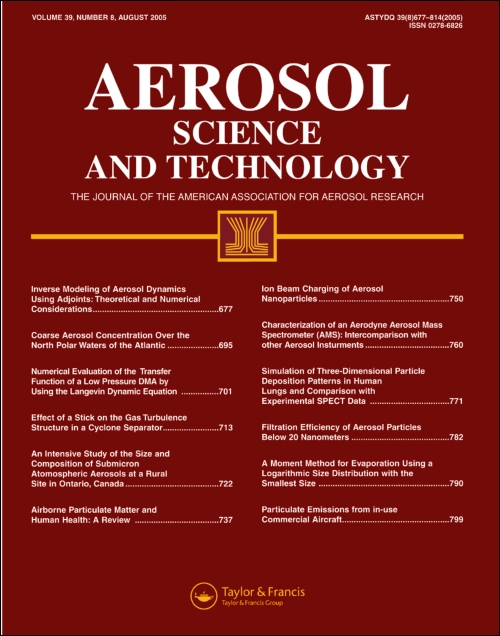通过单个流动颗粒测量圆强度差散射(CIDS)的快速生物气溶胶检测
IF 2.1
4区 环境科学与生态学
Q2 ENGINEERING, CHEMICAL
引用次数: 0
摘要
摘要本文提出了一种先进的光学方法来测量单个气溶胶粒子流动的圆形强度微分散射(CIDS)的相函数,即归一化穆勒矩阵元-S14/S11。利用32阳极光电倍增管及其相关电子器件与椭圆反射器相结合,记录了一个粒子被左旋和右旋圆偏振激光束依次围绕反射器焦点照射时的散射相函数。新设计不需要传统的锁相放大器、偏振调制器和旋转测角仪。最高可达5万个粒子/秒的粒子检测能力。测定了色氨酸颗粒、聚苯乙烯乳胶微球、大肠杆菌、枯草芽孢杆菌孢子、罗氏耶尔森菌和噬菌体MS2聚集物的CIDS相功能,结果表明该方法具有快速区分单一生物气溶胶和非生物气溶胶颗粒的能力。关键词:圆形强度微分散射(CIDS)穆勒矩阵元素-S14/S11生物气溶胶粒子手性螺旋弹性光散射散射相位函数免责声明作为对作者和研究人员的服务,我们提供此版本的接受稿件(AM)。在最终出版版本记录(VoR)之前,将对该手稿进行编辑、排版和审查。在制作和印前,可能会发现可能影响内容的错误,所有适用于期刊的法律免责声明也与这些版本有关。本文章由计算机程序翻译,如有差异,请以英文原文为准。
Rapid bioaerosol detection by measuring circular intensity differential scattering (CIDS) from single flowing through particle
ABSTRACTWe present an advanced optical method to measure the phase function of circular intensity differential scattering (CIDS), i.e., the normalized Mueller matrix element -S14/S11, from individual single flowing through aerosol particles. Here, a 32-anode photomultiplier tube and its associated electronics, combined with an elliptical reflector, were used to record the scattering phase functions, when a particle were illuminated by a left-handed and a right-handed circular polarization laser beam around the focus of the reflector successively. The new design does not need lock-in amplifier, polarization modulator, and rotating goniometer as the traditional setup. It can reach a particle detection ability with a maximum rate of 50,000 particle/sec. CIDS phase functions from tryptophan particles, polystyrene latex microspheres, aggregates of Escherichia coli, Bacillus subtilis spores, Yersinia rohdei, and bacteriophage MS2 were measured, the results showed that this method has the ability to rapidly discriminate between single bioaerosol and non-bioaerosol particles.Keywords: Circular intensity differential scattering (CIDS)Mueller matrix element -S14/S11 Bioaerosol particlesChiralitySpiralElastic light scatteringScattering phase functionDisclaimerAs a service to authors and researchers we are providing this version of an accepted manuscript (AM). Copyediting, typesetting, and review of the resulting proofs will be undertaken on this manuscript before final publication of the Version of Record (VoR). During production and pre-press, errors may be discovered which could affect the content, and all legal disclaimers that apply to the journal relate to these versions also.
求助全文
通过发布文献求助,成功后即可免费获取论文全文。
去求助
来源期刊

Aerosol Science and Technology
环境科学-工程:化工
CiteScore
8.40
自引率
7.70%
发文量
73
审稿时长
3 months
期刊介绍:
Aerosol Science and Technology publishes theoretical, numerical and experimental investigations papers that advance knowledge of aerosols and facilitate its application. Articles on either basic or applied work are suitable. Examples of topics include instrumentation for the measurement of aerosol physical, optical, chemical and biological properties; aerosol dynamics and transport phenomena; numerical modeling; charging; nucleation; nanoparticles and nanotechnology; lung deposition and health effects; filtration; and aerosol generation.
Consistent with the criteria given above, papers that deal with the atmosphere, climate change, indoor and workplace environments, homeland security, pharmaceutical aerosols, combustion sources, aerosol synthesis reactors, and contamination control in semiconductor manufacturing will be considered. AST normally does not consider papers that describe routine measurements or models for aerosol air quality assessment.
 求助内容:
求助内容: 应助结果提醒方式:
应助结果提醒方式:


